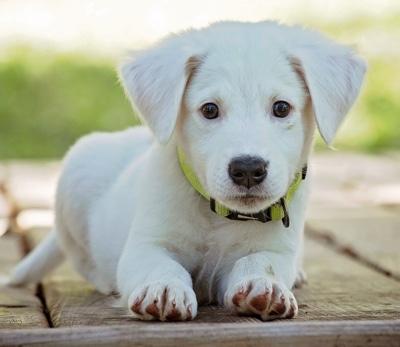Potty training your dog is an important step in your puppy’s integration into your home.
To be successful, knowing what to do and establishing a consistent, predictable routine is important. Preventing your puppy from eliminating in your home and providing a designated potty area in your yard is the first and most important task.
To achieve this, you need a safe, comfortable confinement area consisting of an:
- Appropriate-sized crate
- Exercise pen
- Baby gate
When you’re unable to supervise your puppy, you need to confine him so he doesn’t eliminate indoors.
I do not recommend using pee pads because they’re unsanitary and teach your puppy that it is ok to potty inside.
When you bring your puppy home, take him from the car straight to the designated area outside where you want him to go. Ensure no other people, children or dogs are present to distract or intimidate the new family member. Wait calmly for as long as it takes.
After introducing the puppy to your family and allowing him to drink or have a snack, take him outside to the same area again. Then bring him inside to his crate for a short rest.
Crate training helps your dog to be successful at potty training, as dogs naturally avoid soiling their sleeping area.
A young puppy needs to eliminate every hour when awake and several times during the night as his bladder is not fully developed until up to 6 months of age. Keep his crate in your bedroom so you can hear your puppy when he wakes up.
To be successful in your training, a daily routine is important. Documenting this helps you gain control over when your puppy needs to potty.
Daily Routine
To establish a routine, take your puppy out on-leash to the designated potty area within 15 minutes of eating and after:
- Drinking water
- Waking up from a nap, during the night and first thing in the morning
- A training session
- A play session
Add a cue like “go pee” or “go potty” and say once only. Wait until it happens and then praise and reward him with a high-value treat.
Then have a short play session afterwards so the puppy learns that he has to potty first.

Be aware of your puppy’s “gotta go” signals—pacing, circling and sniffing—are sure signs. You could also teach your dog to nudge a bell, hung on the door, to indicate to you that he needs to go.
Interrupt with an “ah, ah, potty time” if you catch your puppy in the act of doing it inside and take him out to finish.
Give him many opportunities to eliminate outdoors and richly reward each time.
If you live in an apartment building, you may not be able to get your puppy down the elevator and out the door in time. If this is your situation, try using a canine litter box with fake grass and place it on the balcony.
When your puppy enjoys success at going outdoors, increase the size of his confinement area by using an exercise pen outside the crate, which has the door tied open or removed.
Never chastise your dog for having an accident in the house.
Prevention and supervision when outside his confinement area is important—dogs will sneak off and eliminate in the house if yelled at for doing this. Remove small mats and area rugs until potty training has been completed.
When your puppy has an accident in the home, you need to spray the area with an enzyme-based cleaner such as Nature’s Miracle to remove every scent-bearing molecule of the urine or feces. Otherwise next time, your puppy’s subconscious brain will signal that it’s time to pee or poop in the same place.
Vinegar and household cleansers will not completely remove the smell from the area. Bleach will burn his delicate nostrils, so it should never be used.
Your Next Step
In addition to teaching your puppy to go in the designated potty area at your home, it’s important to encourage him to potty in various outdoor places such as parks, back alleys, woods and river banks during regular walks. Be sure to add the “go pee” or “go potty” cue and praise and reward each time he does it.
Being exposed to different surfaces also improves his adaptability to new environments. You don’t want your dog only feeling safe to eliminate in your backyard.
Housetraining Regression
If your house-trained dog begins to potty in the home, first check with your veterinarian to insure there is no physiological reason for this like a urinary tract infection.
Monitor your dog’s water and food intake so you can let your vet know if there are any changes which can signal other health problems.
If there is no physiological reason for his inappropriate behaviour, repeat the basic potty training steps, including confinement, when you can’t directly supervise him.
House soiling may also occur due to major life changes such as moving to a new home or the addition of a baby or another dog to the household. This can trigger stress and inappropriate behaviours in your formerly well-behaved canine companion.
Potty training sets your dog on the right path, keeps the house clean and strengthens your bond with him.

